GLOBAL LNG REPORT
Broadening LNG market presents
opportunities, challenges
An industry SWOT analysis shows Mexico and Canada are poised to make major strides in the US, while liquefaction and regasification capacities expand worldwide.
David Wood, David Wood & Associates, Lincoln, UK; and Saeid Mokhatab, Contributing Editor, LNG, World Oil
LNG constitutes a global, rapidly evolving industry. The increasing length of LNG supply chains is demonstrated by participation of different National Oil Companies (NOCs), International Oil Companies (IOCs) and energy utilities.
The involvement of varied parties aims to realize maximum value, distribute risk and secure LNG supply and/or gas offtake. In many supply chains, the components are becoming quite fragmented. In some cases, full deregulation of downstream gas markets, short-term contracts, swaps and non-dedicated destinations provide increasing flexibility for LNG and gas markets, thereby affecting risks and opportunities. The LNG supply chain requires comprehensive, integrated risk and opportunity assessment, management, mitigation methods and solutions.
The US traditionally supplies its gas markets from domestic production, supplemented by significant imports from Canada. LNG regasification plants are now being constructed along Mexico's coasts, ultimately to be linked into the US gas pipeline network.
SWOT ANALYSIS
The recent expansion and diversification of the international LNG market means that its Strengths/Weaknesses/Opportunities/Threats (SWOT) are also evolving rapidly, Table 1. These items should provide a useful starting point for analysis of specific supply chains, which typically are influenced by some of the items identified.
| TABLE 1. High-level generic 2007 SWOT analysis for the LNG industry |
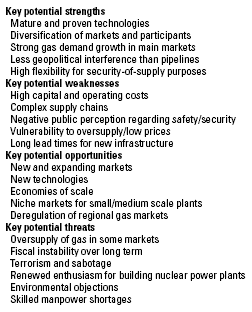 |
|
As with most SWOT analyses, some items are strengths or opportunities for certain players, but weaknesses for other firms in the same LNG supply chain. For example, attitudes to deregulation will differ depending on whether one holds and strives to maintain a monopoly share in an existing regulated market, or is a new player trying to break into that market.
In more detailed SWOT analysis, there is, therefore, no reason why some items cannot appear under more than one category. The key items listed here only represent a starting point for a detailed SWOT analysis. The latter should go far beyond the issue-listing approach, and develop scenarios and strategies to exploit strengths and opportunities while mitigating weaknesses and threats. However, even meaningful lists of issues for each element of the generic SWOT analysis are difficult to construct without a detailed understanding of the evolving structure and contractual relationships of the LNG supply chain. 1
Appropriate strategies for success will depend on the nature and perspective of the participant (i.e., NOC, IOC, contractor, financier, insurer, shipper, trader, utility, etc.). Clearly, different items have more relevance to some participants than others.
STRENGTHS TO FOCUS ON
Technological advances and economies of scale are affecting liquefaction (7.8-million-t/yr train sizes are under construction in Qatar), LNG shipping (carriers in excess of 200,000-m 3 capacity are being built in South Korea for Qatargas) and regasification (LNG storage tanks with capacities of 200,000 m 3 are being built or planned for several projects).
A broadening supplier and customer base for LNG is developing, Fig 1. Several countries, including Equatorial Guinea, Norway and Russia, are in an advanced stage of constructing liquefaction plants and will become LNG exporters in the next three years, Table 2. Others, like Angola, Peru and Yemen, have new projects sanctioned or awaiting final investment decisions and will become LNG exporters by 2010. In addition, established LNG exporters like Australia and Nigeria are sanctioning new trains and greenfield plants following Qatar's lead in 2004 and 2005.
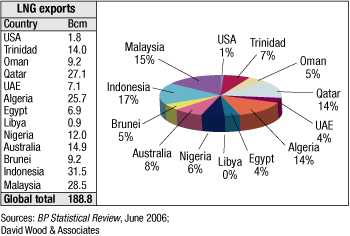 |
Fig. 1. Global LNG exports by country. Four countries (In-donesia, Malaysia, Qatar and Algeria) accounted for 60% of global LNG exports in 2005.
|
|
| TABLE 2. Countries exporting/planning to export LNG |
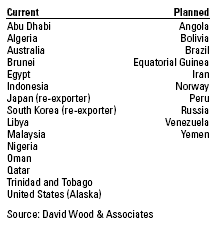 |
|
Even more countries are involved in expanding LNG regasification. Established LNG importers like the US, Spain, Italy, France and the UK are leading the way, Table 3. New entrants like Mexico and Canada are constructing greenfield plants, and many others are reviewing plans to build new plants. Some of these plans seem certain to materialize, like those in the Netherlands and Chile, while several may be negotiating options with which to bargain with traditional pipeline gas suppliers, like Germany and Poland with respect to pipeline gas from Russia.
| TABLE 3. Countries importing/planning to import LNG |
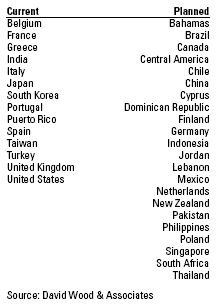 |
|
Thus, an unprecedented number of liquefaction and regasification plants are under construction or in planning. This suggests that forecasts of 10% annual growth in global LNG imports (up from 7.5% forecasted in early 2004 2 ) through the next decade should be achieved, if not exceeded, Fig. 2. Many analysts predict LNG imports exceeding 300 Bcm by 2010.
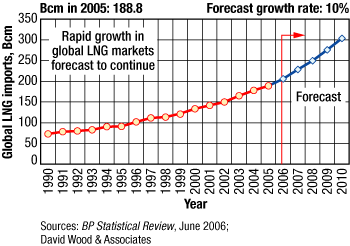 |
Fig. 2. Global LNG imports�history and forecast.
|
|
Annual US consumption of natural gas increased from about 5 Tcf in 1949 to a peak of more than 23 Tcf in 1972 (about 63 Bcfd). After falling back throughout most of the 1980s and '90s, gas consumption resumed a steady upward climb to about 23 Tcf in 1998. It has hovered between about 62 and 65 Bcfd since 1998, constrained at times by import capacity, Fig. 3.
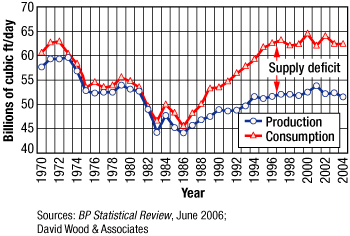 |
Fig. 3. Historical US gas production and consumption trends.
|
|
Canada has evolved as a key exporter to the US, supplying about 16% of US-consumed gas, Fig. 4. From 2000 to 2003, this represented 57�60% of natural gas produced in Canada.
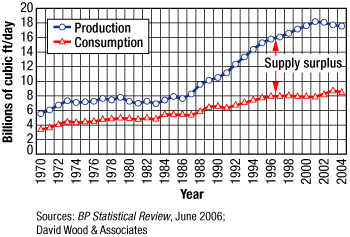 |
Fig. 4. Historical Canadian gas production and consumption trends.
|
|
WEAKNESSES TO CONSIDER
Public perception of LNG as a high safety and security risk has significantly delayed progress with much-needed regasification plants along the northeastern US coast and has slowed approval for projects in Italy. Some environmental groups and law firms have exaggerated the safety and security concerns. The industry must maintain and promote its excellent safety record, because the opposition posed by NIMBY-ism (�Not In My Backyard�) could cause lasting damage.
Barriers to entry for all but the largest organizations benefit only a few large IOCs and NOCs. As the industry matures, independent operators should be able to participate, driving down costs and improving efficiency as they have done in so many other industry sectors. Signs that this is starting to happen include Marathon's lead role in Equatorial Guinea's Bioko LNG project; Anadarko's Bear Head regasification terminal in Canada; Hunt Oil's lead role developing the Pampa Melchorita liquefaction plant in Peru; and Petro-Canada's alliance with GazProm to develop a new LNG supply chain from Russia to Canada to the US. However, smaller-scale projects need to progress further.
Tight control of gas reserves by state-controlled companies or geopolitically difficult regions is a factor the industry has little choice but to live with.
The main petroleum-consuming members of the Organization for Economic Cooperation and Development (OECD) view the oil industry and particularly OPEC as maliciously responsible for current high oil prices. Sustained high gas prices in OECD countries risk persuading these politicians that gas will ultimately go down the same political road as oil.
With this mindset, OECD governments may develop energy strategies that see gas as part of the energy problem rather than an excellent technical, commercial and environmental solution. If they do so, gas, and particularly LNG, which requires such high infrastructure investments, will struggle to expand its market share.
High costs and limited competition among suppliers remain a weakness. The industry did well to reduce costs in the decade before 2002. Since that time, materials and supplier costs have risen, and projects are struggling to stay within budget, with some significant cost overruns, as in Sakhalin (Shell-Russia) and Snohvit (Statoil-Norway). By re-focusing on smaller projects, the industry may be able to reverse the trend to higher costs.
OPPORTUNITIES FOR 2007
Securing market share based on security of supply is probably LNG's most significant opportunity in the medium term. Events of 2005 and 2006 have demonstrated in the US and Europe that gas supplies by pipelines between two fixed locations are an optimal solution when they can supply gas, but expose significant security-of-supply issues when they are shut down.
Such shutdowns can result from severe weather interruptions, like the 2005 Gulf of Mexico (GOM) hurricanes, or political disputes like the January 2006 price disputes between the Ukraine and Russia, which cut supplies to Germany and Italy for several days during peak demand. These shutdowns have heightened awareness that a flexible supply system with gas coming from several sources offers the best chance of uninterrupted supplies in the event of unforeseen crises. LNG offers flexibility and the opportunity to diversify supply sources. This is the industry's strongest card in 2007, and it is why so many European countries are seeking to build regasification terminals.
Integrating regasification infrastructure into distribution networks is of vital importance for enabling gas flow to customers. Owners of gas distribution and storage facilities are able to extract the most value from gas supply chains�much more than producers�except when wellhead prices remain high for sustained periods. So too with LNG receiving and regasification infrastructure, which is why both large and small companies are so keen to invest in new North American facilities. These new facilities will be able to provide capacity to meet the increased demand for gas to feed power plants and to replace domestic production as it declines.
Recent years have seen rising US interest in LNG at portside regasification and storage facilities in large urban centers. However, local referenda on planning approvals have repeatedly defeated or stalled such developments, particularly in ports north and east of the Boston-Portland corridor and in California. Delayed approval of some new LNG receiving terminals, particularly along the Northeast coast, has prompted some gas companies to look to Canada as an easier location for such facilities and to tie them into underused existing pipelines like the Maritimes and Northeast pipeline.
This holds particularly profound implications for the development, mainly by US companies, of natural gas production in the Gully Zone of Sable Island field on Nova Scotia's Atlantic Coast. Although the gas find was developed entirely with US markets in mind, its estimated life is only about 20 yr. The main longer-term asset developed with it seems to be the Maritimes and Northeast pipeline running from Goldboro, where Sable Island gas is brought ashore, to the Boston-area suburb of Everett, the nearest US distribution point and the site of an LNG receiving terminal.
A survey of the Canadian energy industry in the winter of 2005 by the US Energy Information Administration (EIA) noted that �while not without controversy, the Canadian LNG terminals have not met with the same level of resistance from local residents and environmentalists that similar facilities in the US have faced.� In connection with the Maritimes and Northeast pipeline, two proposals won approval in 2005 from Canada's National Energy Board (NEB) and progressed into construction:
� A facility with expected initial throughput of 0.5 Bcfd, owned and operated by Irving Oil Ltd., will connect to the pipeline. Irving, based in Saint John, N.B., is Canada's largest privately held, vertically integrated oil refiner, and markets and operates the country's largest refinery (250,000 bpd).
� A facility with expected initial throughput of 1.0 Bcfd was fast-tracked into construction at Bear Point, N.S., near the pipeline's Goldboro terminus, by Anadarko Petroleum in 2005. However, in early 2006 Anadarko announced a slowdown in construction until a longterm LNG supply contract was secured, and the company sold the asset to Venture Energy in mid-2006.
In total, there are plans to build more than 4 Bcfd of LNG receiving capacity by 2008 in eastern Canada alone, with additional LNG-terminal proposals on the Pacific and Atlantic coasts in various stages of review by the NEB.
Even before these latest Maritimes-based projects, a $1.3 billion, 500-MMcfd LNG terminal was approved for construction by Petro-Canada and TransCanada Pipelines at Gros Cacouna, Que., along the St. Lawrence River. The approval was apparently connected with a deal between Petro-Canada and Russia's Gazprom to feed the Gros Cacouna terminal from Gazprom's much-heralded, but not yet developed, Shtokman field. 4 The terminal may also be fed from other sources of Russian gas�still in the feasibility-study phase�being considered for export as LNG from Ust-Luga on the Gulf of Finland.
Mexico has proved natural gas reserves estimated (as of January 2006) at about 15 Tcf. In 2005, Mexico was the 15th largest producer of natural gas, accounting for about 1.6% of worldwide production, but its growing demand for this resource has made it a net importer. Gas has recently come by pipeline from the US, but high prices and tight US demand have led Mexico to seek its own LNG import capacity.
Mexico is now the 11th-largest user of natural gas, accounting for about 1.9% of worldwide consumption. Natural gas use in Mexico is now more than 90% greater than it was a decade ago, a result of growing reliance on gas-fired power generation. This will account for nearly half of all natural gas consumed in Mexico within the next decade, and overall Mexican consumption is forecast to increase at 3.3% annually from 2004 to 2030. 5
Mexico's dependence on natural gas imports, like that of the US, is projected to increase, Fig. 5. Natural gas imports are expected to grow from 13% of Mexico's consumption in 2002 to about 40% by 2030.
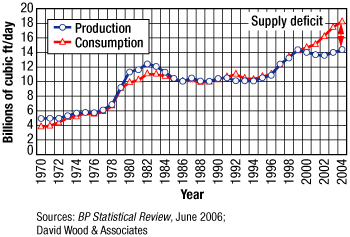 |
Fig. 5. Historical Mexican gas production and consumption trends.
|
|
LNG is expected to be the biggest contributor to Mexico's additional natural gas supply in the near term. The Costa Azul import facility under construction in Baja California will serve both Mexican and US markets. The recently commissioned Altamira facility on Mexico's Gulf Coast is the first to import LNG. Also, several LNG-receiving facilities are under consideration along Mexico's Pacific Coast, primarily to serve the domestic market. Several major companies have sanctioned investments in Mexico in recent years to achieve access to the lucrative Californian gas market. For example, Repsol YPF has taken positions in Mexico and Peru along a new LNG supply chain targeting entry to the North American Pacific Coast. Across the Pacific, the controversial Sakhalin II project in eastern Russia and Indonesian and Australian liquefaction projects are also looking at lucrative supply contracts into the West Coast US market.
Smaller-scale liquefaction offers the long-term key to unlocking much of the world's stranded gas reserves, which are often quoted as exceeding 2,500 Tcf (more than 40% of total proven reserves). What is less often considered is the fact that most of these stranded reserves are in fields that individually hold less than 5 Tcf. The major IOCs have generally chased projects for large-scale LNG supply chains, which require fields with reserves in excess of 10 Tcf. The largest IOCs consider reserves much smaller than that immaterial. Unfortunately for them, less than 200 gas fields worldwide have reserves greater than 5 Tcf, and most of them are either in production or contracted for development.
On the other hand, about 200 non-producing fields have gas reserves of between 1 and 3 Tcf. Surely the way forward for the industry is to focus on these smaller stranded reserves and bring smaller-scale technology championed by the independent sector to bear on these fields. As the LNG supply chains become more diversified, opportunities to trade LNG produced from smaller plants should materialize. LNG Ltd of Australia is striving to become a niche player in this smaller market with a 1.8-MMtpy plant at Padang, Indonesia, where a front-end engineering and design phase to develop two gas fields is underway. The company also has a cooperation agreement with Iran for a small plant on Qeshm Island.
Offshore regasification and liquefaction have the potential to open new supply chains. In regasification, offshore technologies are now in use. Excelerate's Gulf Gateway Energy Bridge shipboard regasification system deployed in the GOM in 2005, and another, called Northeast Gateway, is planned for Massachusetts Bay. Various gravity-based and floating systems are awaiting permission for deployment as deepwater ports, like the LNG Adriatic Terminal planned for construction off the coast of Rovigo, Italy. The terminal, which will be owned jointly by Qatar Petroleum, ExxonMobil and Edison, is expected to start importing gas in 2007 through a concrete Gravity-Based Structure (GBS) with a capacity of 318 Bcfy of gas and storage space for 8.8 MMcf of LNG.
Another planned GBS is Shell's Gulf Landing regasification terminal to be located 38 miles off the Louisiana coast on West Cameron Block 213. This GBS is planned to deliver up to 1 Bcfd and is scheduled to be operational in 2008�09 with connections to as many as five major interstate pipelines. On the other hand, Chevron in 2005 put on hold indefinitely its Port Pelican deepwater port proposal, also in the GOM, following the award of planning permission, and ExxonMobil withdrew its Pearl Crossing planning application. High cost associated with environmental compliance gave these two US majors second thoughts.
If costs, engineering and environmental issues can be overcome, offshore regasification terminals could open new markets. For example, Stag Energy, a small Scottish company, unveiled plans in 2006 for a floating LNG terminal close to England's northeastern coast. Barrow Gateway terminal would be linked to an offshore underground salt cavern with gas storage capacity of about 1.1 Bcm. That project is far from being sanctioned, but such opportunities are considered serious options for importing LNG into areas where onshore terminals are difficult to build.
Unlike regasification, offshore liquefaction has yet to materialize in a commercial project, despite substantial R&D investments by companies like Shell and Mobil since the late 1980s. As always, the majors have focused on large-scale offshore projects. Shell pushed hard�unsuccessfully�for the Sunrise development off northwestern Australia, for which the company supported a floating liquefaction solution, and it has collaborated with Statoil for three years seeking such a solution for the deepwater Nnwa Doro field off Nigeria, also with no reported progress. Regardless of the technical issues, many governments prefer a land-based liquefaction plant for control and local employment reasons.
In 2005, ABB announced its �LNG Alone� small-footprint offshore liquefaction scheme, which focuses on smaller-scale (0.5 to 3 Tcf) fields. However, many in the industry remain skeptical that offshore liquefaction can be deployed within a realistic commercial cost framework. Securing finance and government approval for the first offshore liquefaction plants will prove difficult, but if the technology can be demonstrated, many opportunities exist. Analogies can be drawn to skepticism toward FPSO technology in the early 1990s. FPSOs have now been widely embraced internationally for large, deepwater oilfield developments and shallow, marginal fields on a smaller scale.
Integration of LNG and GTL technology offers opportunities for some large-field developments. The Gas-to-Liquid (GTL) process produces surplus power in the exothermic Fischer-Tropsch process step, although it consumes substantial energy in the syngas step. A typical GTL plant can generate surplus power of about 50 MW from a 30,000-bpd-capacity plant plus some surplus steam. On the other hand, LNG consumes power in its compressors. At the Doha Gas Conference in 2005, Axens/IFP of France described an integrated scheme where GTL and LNG plants built together could share energy, steam and gas pre-treatments and offsites (port, loading and supply/storage facilities) to achieve overall efficiencies. Such integrations clearly present opportunities for countries holding large gas reserves.
THREATS TO CONSIDER
Sustained high prices for gas could increase the threat from low-price coal and long-term nuclear strategies. The industry should not assume that growth in market share is guaranteed. Sustained high gas prices in OECD countries may provide short-term profits for LNG and gas suppliers, but they could have very negative medium-term implications. More consuming nations may sanction coal and nuclear solutions than would have been the case if gas prices had remained below $5/MMbtu over the past two years.
New nuclear plants are an especially large long-term threat. Power generation is imported LNG's primary use, and it has to remain competitively priced in the long term against coal and nuclear solutions. For nuclear plants, the main economic hurdle is the high initial capital investment. Once built, their unit cost of power supply is quite low. For gas-fired plants like combined-cycle gas turbines, initial capital costs are relatively modest, but unit cost of power is strongly affected by the price of gas. The LNG and gas industry should not lose sight of this if it wants to avoid marginalization.
One serious accident or security incident at a regasification plant or associated with an LNG carrier could seriously damage the industry's reputation and limit or slow capacity expansions. Even with its excellent safety and environmental record, the LNG industry is vulnerable to the adverse publicity that would arise from a serious safety or security incident. Opponents of new regasification plants would gain ammunition in their fight. The industry needs to maintain its high safety standards, remain vigilant on the security front and take seriously all measures to guard against terrorist attacks.
Manpower and skills shortages and high costs of materials and services are problems facing the whole petroleum industry. Because the LNG supply chain is capital intensive and its complexity requires specialist skills, it is particularly vulnerable to these problems. Add to this the remote locations of many liquefaction projects in planning and under construction and it is clear that high costs and labor shortages, if they persist, may lead to delay or cancellation of some projects. The industry cannot sustain many projects like Sakhalin before the financial sector becomes more cautious about backing future projects.
On the manpower front, the petroleum sector is paying the price for its downsizing and lack of training in the 1990s, when many skilled professionals who were treated poorly by the major companies left the industry. Those major companies are finding it hard to secure staffs that will put up with constraints and narrow skill sets without job security.
The US's increasing dependence on its neighbors for transiting natural gas supplies will give Canada and Mexico an increasingly important position. Canada's key role in this regard will be along the northern Atlantic Coast feeding gas to northeastern US demand centers, whereas Mexico will likely be pivotal in providing California access to imported gas from Pacific LNG suppliers. Rejection of new LNG regasification plants in the US on planning and environmental grounds will increase this dependence over the next decade. 
LITERATURE CITED
1 Wood, D., �LNG risk profile�Where are we going: SWOT analysis aids risk assessment,� Oil & Gas Journal, Feb. 14, 2005
2 Wood, D., �LNG's share of global gas set to soar,� Petroleum Review, Feb. 2004.
3 National Energy Board, �Canada's conventional gas re-sources: A status report�April 2004,� 2004.
4 US Department of Energy, �Country Analysis Brief Canada,� Feb. 2005.
5 International Energy Agency, �World Energy Outlook�2006, Reference Case,� 2006.
|
THE AUTHORS
|
|
David Wood is an international energy consultant specializing in the integration of technical, economic, risk and strategic information to aid portfolio evaluation and management decisions. He holds a PhD from Imperial College, London. He can be contacted at: woodda@compuserve.com.
|
|
 |
Saeid Mokhatab is an adviser of natural gas engineering research projects at the Chemical and Petroleum Engineering Department of the University of Wyoming and an international associate of David Wood & Associates, Lincoln, UK. He has published more than 50 academic and industry-oriented papers and books.
|
|
|












